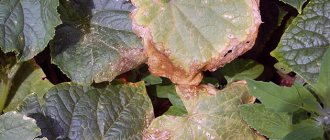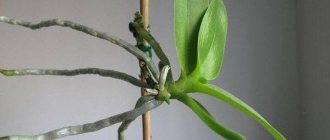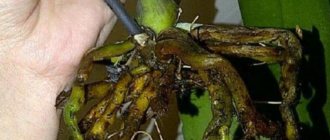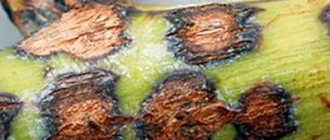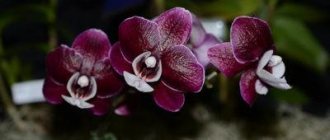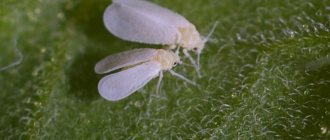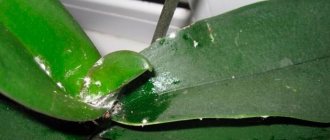Orchids have been talked about with enthusiasm and admiration for many centuries . And they are worth it.
Many works of outstanding botanists are devoted to them. Ancient Chinese artists and thinkers did not leave these beautiful flowers without their attention.
Nowadays, even with an impressive collection of orchids it is not always possible to surprise.
already growing them . They create optimal conditions not only in greenhouses and winter gardens, but also in normal conditions at home and in apartments. There are flower growers who see this as a profitable business. They advise, reproduce and implement.
An orchid may develop various diseases.
They have to deal with various diseases of these beautiful flowers. Let's find out more about some of them. Below we will tell you why black rot and dots appear on the orchid.
What is it, what do they look like?
Spots on orchids are a sign of damage to the flower , which can be of viral or bacterial origin. They may differ in color, shape and degree of distribution.
Photos of affected plants
Here is a photo of orchids with spots on leaves and flowers:
On what parts of plants do they appear?
An orchid is a single organism, and spots can appear on any part of the plant. Therefore, if black dots or other spots appear on orchid flowers, then you urgently need to isolate the plant from other indoor flowers, inspect all parts, and observe for a while. Damage to the root system is the most dangerous, since it is difficult to notice them in the first stages of the disease. However, most often the orchid suffers all at once from improper care and disease. If spots appear on orchid flowers, then when examining the root system, flaws will be noticed.
Definition
- Belykh.
White spotting on leaves - what does it mean and for what reasons does it occur:- Chlorosis. This is not so much a disease, but only a symptom of previous diseases. It is distinguished by vague white spots on the leaf plate.
Powdery mildew. This is a fungal disease that causes purple-white spots on the leaf. Externally, the flowers look as if they were sprinkled with flour. This disease, if not treated promptly, can lead to the death of the plant. Read about white plaque on an orchid and how to combat it here.
- Chernykh .
If black round and small spots with a concave surface appear on the leaves of the orchid, then this is a sign of anthracnose. After a while, a pink or yellow coating appears. Late blight remains the next cause of black spot development. Over time, black spots spread over the entire surface of the leaf. Pathogen spores can remain in the soil for a long time. Read more about blackening of orchid leaves, flowers and roots here. - Brown.
Spots with a brown tint occur with the following pathologies:- Rust. This is a rare disease that affects orchids. It is a fungal infection that infects the leaf blade. Mostly weak orchid bushes are affected by the disease. It appears in the form of spots from the inside of the leaf blade, which acquire a reddish-brownish tint. This causes sporulation of fungi.
Rot. This is a common disease of orchids. Appears on the leaf plate in the form of brown spots with a fluffy formation.
- Hives. This disease is easily recognized by the presence of small brown spots, 3 mm in diameter. Over time, pigmentation spreads over the entire surface of the leaf.
- Wet.
Wet spots on orchid leaves occur as a result of the activities of the following pests:- Bristle bug. This parasite has a distinct reddish body color and an oval shape.
Citrus mealybug. This pest can take on different body colors: from orange to black.
When a flower is damaged by these pests, wet spots of white, pink and beige colors form on the leaf plate.
We invite you to watch a video about white spots on orchids:
Read about diseases of orchid leaves here.
How to save an orchid? Treatment of orchid diseases. Care problems
How to save an orchid? Treatment of orchid diseases. Care problems
Today I will share with you all the secrets of saving orchids from diseases and teach you how to solve some of the problems that arise when caring for orchids . Despite their delicate and fragile appearance, orchids are incredibly hardy. You can almost always save an orchid
Out of ignorance, many breeders make mistakes. Sometimes the joy of expecting something beautiful gives way to disappointment. The reason for this may be withered leaves and buds , lack of flowering , spots on leaves and flowers , as well as more serious orchid diseases .
Agree, the orchid is an incredibly beautiful flower that came to us from Asia. Every flower lover most often purchases several of these wonderful plants. Their beauty and alluring aroma are simply mesmerizing and, having brought this beauty into the house, we begin to carefully care for it.
Orchid does not bloom
Of course, having acquired such beauty, I really want the orchid to bloom as often as possible, but sometimes such disappointment occurs as a long absence of flowering.
This problem can occur for several reasons:
- The first is when you just can’t find a place for it, and you keep carrying it around the house looking for something better, waiting for it to bloom. In fact, by doing this you only slow down the release of the peduncle of the orchid. When moved to a new place, it begins to adapt again and all its energy goes towards this, and not towards flowering. Find her one permanent place for the entire rest period.
- Lighting plays a very important role in flowering. There should be a lot of light, but of course not direct sunlight. If it has very little light or, on the contrary, too much light, it will not bloom for a long time. Place it close to the window, but so that the sun does not shine on it.
- Poor root system. If there is no flowering for a long time, then there is a reason to remove it from the pot and examine the root system. Perhaps root rot has appeared or, on the contrary, the roots are drying out. Then it’s worth starting to resuscitate the plant. You will learn further by reading this article about how to save an orchid with problems with roots and what problems you may still encounter.
Orchid buds wither and dry out
Having brought the orchid into the house after a few days, everyone notices that such beautiful and desirable buds began to wither, and then dry out and fall off. All of them, of course, never fall off, but the other pair always withers and dries up. Many people start to panic and it seems to them that the plant is spoiled or sick, or maybe it urgently needs to be watered or put in the sun, or maybe removed. All this panic is completely unnecessary.
Substrate for orchids
Your orchid is simply adapting. She has come a long way to you from Asia or came from a special greenhouse. But, one way or another, the orchid lived in completely different conditions, where there was an ideal climate, temperature and humidity - they were ideal for it. It’s like sending a resident of Siberia to live in Africa with year-round heat. The same thing happens with the orchid. It simply begins to adapt, and so that the entire plant as a whole does not suffer damage, the orchid gets rid of several buds so as not to waste on them the valuable nutrients that are needed for adaptation. When the orchid is fully adapted, it will no longer shed buds.
But if an orchid has been living in your house for a long time, and suddenly the buds begin to fall off, then you should start looking for the reason for this behavior of the plant. Perhaps it has acquired a neighbor in the form of parasites or, again, the root system is not in order.
The appearance of spots on orchid flowers
Spots on orchid flowers rarely appear due to disease; the main reason for their appearance is mechanical damage. They usually dry out and the edges of these spots are always uneven.
Spots on orchid petals
They may appear during transportation if condensation has occurred inside the package and the flowers were in very high humidity.
Also, such spots appear due to the fact that the flower was in the sun and there were drops of water on the flowers. In this case, the drop acts as a water lens and the flower receives a burn, which you see on the flower in the form of spots.
Quite rarely, but still not excluded, this is a fungal infection of the plant. In this case, spots appear very quickly. Within just one day, all the flowers can become covered with spots. Next, the entire plant will be affected by the fungus, the stems and foliage will become watery and mold will quickly appear on them. In this case, it is urgent to treat the entire plant with an antifungal agent, which can be purchased at any specialty store. Also, such a plant must be placed separately from the rest, otherwise all the plants nearby, especially orchids, will be infected.
Rot on orchids
Rot is one of the most terrible enemies of the orchid, which has killed quite a few representatives of this beautiful plant. It comes in several types. Now we will look at each type of rot separately and learn how to save our beauties from it.
Brown rot
It is simply impossible not to notice brown rot It appears on the leaves. This is a watery, brown spot on a leaf. If you allow it to grow and develop, the entire plant will eventually rot. Brown rot appears if you water the orchid incorrectly, or if you start spraying it generously. Then water will get into the base of the leaf, and it will begin to rot.
Of course, you can save the plant, but only if you start fighting immediately. But if the rot develops severely, then, alas, the orchid will be lost. In order to get rid of it, you need to take a sharp instrument: a knife or something like a scalpel, and treat it with alcohol. Then cut away all the rot, taking some healthy tissue. The cut areas must be sprinkled with crushed activated carbon or ground cinnamon.
Root rot
Root rot is one of the most common causes of death of orchids. It affects the roots.
If you do not notice it in time, then very quickly the rot will destroy the entire root system of the orchid. It occurs due to flooding of the plant. If there is too much moisture, rot will occur immediately. It is quite possible to save the plant, if, of course, resuscitation is started in time.
First you need to remove the orchid from the pot. Shake off all the soil. Then it is necessary to remove the outer shell, which has rotted, from the rotten roots. The root sheath is called the velomen and surrounds the central shaft. Clean your hands with alcohol and carefully pull off all the rotten bicycle leather from the shaft. Usually the rod remains intact, but if the rod has rotted, then cut this root with scissors treated with alcohol.
1) This is what root rot looks like in a pot. 2) Orchid root rot. 3) Velomen. 4) Orchid roots after removing the veloman
Then, when you have removed all the rot, treat all the roots with activated charcoal powder or ground cinnamon.
Then plant the orchid in a new pot and orchid substrate. Place the orchid pot in partial shade and do not water for 3-4 days.
Then take 1 tablet of succinic acid and dissolve it in 1 liter of boiled water. Buy the orchid in this solution a little. Also moisten a cotton pad with it and wipe the leaves. Afterwards, do not bathe her for 10-14 days, or even longer if there is still moisture in the bark (substrate).
Gray rot
It is simply not possible to miss this type of rot. Initially, it appears on the leaves of the orchid and looks like a gray spot with a fluffy coating. If left untreated, it will very quickly spread to the ground, and then attack the entire plant.
This rot occurs when the humidity is very high, but the room temperature is low.
As soon as you see the appearance of gray rot , immediately cut off all areas of rot. Change the substrate and treat the entire plant with fungicides. If after this rot occurs again, then your drug is not effective and it must be changed to another.
Be sure to separate the diseased plant from healthy ones.
Orchids with white flowers are most susceptible to gray rot.
Black rot
Black rot on an orchid
Black rot is very easy to recognize because it is black. Basically, it appears when the plant is too cold, much less often the cause is insect pests.
To combat it, it is necessary to cut off all affected areas with a sharp, sterile object. Sections should be treated with wood ash powder or a solution of Bordeaux mixture.
It is also necessary to transplant the orchid into a new substrate and not water or moisten it for three days.
Fusarium rot
When affected by this type of rot, the foliage becomes soft, it begins to curl and acquires first a yellow and then a pinkish tint.
This disease is caused by high indoor humidity and lack of air ventilation.
It is quite possible to save the plant; you must again remove the affected areas with a sharp, sterile object. Then it is necessary to treat with a solution of “Fundazol” three times in 1 day. Naturally, transplantation into a new substrate is necessary. Place the plant in a drier area.
Powdery mildew on an orchid
Powdery mildew is not uncommon in orchid breeding practice. This disease is very often encountered by those who are just starting to grow orchids and do not yet know everything about caring for them.
Powdery mildew on an orchid
This disease occurs due to the fact that the plants were exposed to the greenhouse effect, in other words, there was a lot of moisture and very hot. This often happens when the orchid is well watered and it is standing near a heat source. As a result, there was a lot of evaporation and, consequently, the plant was exposed to powdery mildew.
It’s simply impossible not to notice it. Powdery mildew appears as a white coating on the foliage and flowers of the orchid. Treatment must be started immediately as soon as you see its manifestation, otherwise it will simply be impossible to save the plant.
The first thing to do is to remove all plaque. If rotting has not yet occurred as a result of powdery mildew, then wiping will be sufficient, but if rot has already appeared under the plaque, then it is necessary to cut off the damaged areas with a sharp, sterile object. Treat the entire plant with Topsin-M.
After the event, be sure to normalize the conditions of your orchid.
Rust on an orchid
Orchids, like all indoor plants, are quite often susceptible to a disease called Rust. This disease is fungal. The disease got its name because of its appearance; it really looks like rust formation.
Rust on an orchid
Weak plants are most susceptible to it. It primarily appears on the foliage of the orchid. The lower part of the leaves is the first to be affected; light spots appear on them first, which many do not notice. As the disease progresses, the spots develop brown raised bumps that look very similar to rust formation. After the lower part, the rust moves to the upper surface of the leaves and, in an advanced stage, affects the entire plant.
As a treatment, it is necessary to remove all foci of the disease by cutting out these spots with a sharp object treated with alcohol. Be sure to sprinkle the cut areas with activated carbon powder. Then treat the entire plant with Rodomil Gold.
Sooty fungus (niello)
Sooty fungus , or as it is also called Black or Chern , is named directly because of its color, namely black as soot.
Sooty fungus or niello on orchid
This fungal disease does not occur on its own or due to improper care. If you notice black spots on your orchid, this means that you are seeing the consequences of the orchid having neighbors. White scale insects, mealybugs or aphids have certainly settled with your beauty. They leave their secretions on the plant, on which this fungus begins to grow.
This fungus completely clogs the stomata of orchid leaves, blocking their access to light. If you do not start prompt treatment, the fungus will very quickly attack the entire plant and it will die; saving such a plant will simply not be possible.
As a treatment, urgently treat the orchid with one of these drugs: “Rodomil Gold”, “Mikosan”, “Skor”, “Topsin-M”.
Move the diseased plant as far as possible from other plants, especially orchids. Be sure to change the soil. When replanting, be sure to wash the roots and sprinkle them with activated carbon powder or cinnamon.
Viral diseases in orchids
Oddly enough, but an orchid can suffer from viral diseases. Of course, this does not mean that you are prohibited from sneezing and coughing near her. An orchid is susceptible to viruses mainly if you manipulated it by cutting off roots or other parts with a non-sterile object and then did not treat the plant in the same way.
The virus manifests itself in the wilting of the plant, the orchid begins to change color, it turns pale and slowly withers. If you have even the slightest suspicion of a virus, be sure to remove it away from others and keep an eye on the plant. The infected plant is treated with an antibiotic solution. This can be Bicilin or another antibiotic diluted in water. The roots are dipped into the solution, and the entire plant is also wiped.
For prevention, it is recommended to treat all orchids in your home with fungicides once a month.
Orchid leaf diseases
Orchid leaves are the most disease-prone part of the plant. And in order not to ruin your beauty, you should familiarize yourself with them.
Anthracnose on orchid leaves
A very common fungal disease.
Anthracnose on orchid leaves
It is impossible to overlook it, you will see tiny brown spots on the leaves, although they are very small, you can see them very clearly. If left untreated they will grow very large, turn black and form holes in the leaves.
This fungus is caused by water that gets into the base of the leaf and high air humidity.
In order to get rid of it, you need to cut out the affected areas with a sterile sharp object and treat the plant with a product containing copper. Treatment must be carried out three times every 10 days.
To prevent such a problem from arising, carefully monitor the axils of the leaves; moisture should not accumulate in them. If it gets there, you must immediately remove it with a napkin.
Bacterial spots on orchid leaves
This disease is much less common than the previous one, but it still happens.
Bacterial spots on orchid leaves
When a disease occurs, the leaves first become yellow, then they darken, and then become soft. Sores appear on the foliage, in which liquid accumulates and spots form.
As a treatment, it is necessary to cut out the resulting ulcers with a sharp sterile object, since they are very small, it is better to do this with the corner of a blade in order to damage the leaf as little as possible. All places where you made a cut must be treated with iodine using a cotton swab.
If treatment was not effective, you will see signs of the disease again within 10 days.
This disease can occur if the plant is sunburned or you overdo it in fertilizing it.
Orchid foliage becomes deformed
Sometimes you can see the foliage starting to become deformed.
Mechanical damage to orchid leaves
The cause may be ordinary mechanical damage during transportation or careless handling of the plant. But this can also happen due to insufficient watering, or if after watering the orchid is exposed to the cold. Another reason is fertilizer with a high nitrogen content.
If you fertilize your orchid with such fertilizer, you will have to abandon it for a while, but it is better to completely replace it with a new one with less nitrogen, in order to avoid a repetition of the situation.
Also adjust the watering and carefully monitor the drying of your orchid’s substrate.
If this does not help, then remove the orchid from the pot and rinse the roots. Then plant it in a new substrate. If after such a procedure your orchid stops growing, do not be alarmed; this is quite normal, it will recover and then grow well.
Orchid leaf burn
Leaf burn is a very common problem, the cause of which is always the owner of the orchid. In their desire to give the beauty some sunshine, inexperienced orchid owners place it in the sun to warm it up after a long winter.
Orchid leaf burn
The main time for burns to occur is spring and summer. Often, even indirect sunlight in summer can cause a burn if there are even the slightest drops of water on the foliage. A drop of water will act as a lens, enhancing the effect of the sun. Therefore, be careful if your orchid is standing even in indirect sunlight.
The burn appears as a spot on the leaf. At first it is just a yellowish spot, then it acquires a dry crust, after which this place dries out completely and forms a hole in the leaf.
The affected areas are always cut off with a sharp sterile object, then the edges must be treated with activated carbon powder.
The plant must be kept out of the sun and watering adjusted. If a burn occurs, it means there was either too much watering (therefore, evaporation formed on the foliage) or too little. It is better if your orchid, after receiving a burn, stands in the shade until it is completely restored.
Mushrooms in a pot with an orchid
Attentive orchid owners can often notice white dots on the bark. Afterwards, if you follow their development, you will clearly see mushrooms that will grow on the same bark; they will remind you of the well-known toadstools. Many people get scared, begin to panic and immediately change the soil and treat the plant with all possible means, fearing that the orchid has become infected and will get sick and die.
But here everything is much simpler. These fungi were simply living in this bark before it even entered the pot of your orchid. And having received moisture, the mushroom began to grow and develop. These mushrooms do not pose any threat to your beauty. Even if it grows, you simply remove it, but most often the mushrooms die on their own and even bring benefits; as they decompose, they provide useful nutrition to your plant.
Save your orchids quickly. Good luck!
What are the reasons for the appearance?
Why do black, brown, white or dark spots appear on leaves and flowers? The following reasons can affect the development of spotting:
Exposure to direct sunlight . It is necessary to choose a flower habitat with diffused direct light.- Excessive watering . If you actively moisten the orchid, this will lead to rotting of the root system, so you need to carefully ensure that the soil has time to dry out before the next watering. Read about how to save an orchid damaged by the flood here, and find out how to carry out resuscitation if the orchid was left without roots in this material.
- Poor ventilation in the pot . Be sure to place a drainage layer in the container. Its height should be at least 1.5-2 cm. You also need to check whether there are holes in the container. They must be large so that the air can circulate fully.
- Lack of room ventilation . The air in the room should not stagnate, but drafts for the plant are also unacceptable. Everything should be in moderation.
- Incorrectly selected flowerpot . The development of the root system depends on the size and material of the pot. The container should not be small, but not too loose. Its size should be 2-3 cm greater than the volume of the rhizome.
- Disturbed irrigation regime . Orchids are classified into 2 types: those that need to be watered from above and those that are moistened by immersion. First, you need to determine the type of flower, as this will prevent water from stagnating in the tray of the pot.
- Bad substrate . You need to choose only the soil that is intended for the orchid; the rest are not suitable. It is important to ensure that the soil mixture is homogeneous and does not form lumps after moistening. The soil should also contain coniferous bark.
- Incorrect application of fertilizers . When choosing fertilizers, be sure to ensure that they are intended exclusively for these plants. You can study the information on the packaging of the mineral complex. And when adding the nutritional composition, you should not overdo it with the dosage.
Read about what to do if your orchid has spots on its leaves, flowers, or roots.
Orchid buds wither and dry out
Having brought the orchid into the house after a few days, everyone notices that such beautiful and desirable buds began to wither, and then dry out and fall off. All of them, of course, never fall off, but the other pair always withers and dries up. Many people start to panic and it seems to them that the plant is spoiled or sick, or maybe it urgently needs to be watered or put in the sun, or maybe removed. All this panic is completely unnecessary.
Substrate for orchids
Your orchid is simply adapting. She has come a long way to you from Asia or came from a special greenhouse. But, one way or another, the orchid lived in completely different conditions, where there was an ideal climate, temperature and humidity - they were ideal for it. It’s like sending a resident of Siberia to live in Africa with year-round heat. The same thing happens with the orchid. It simply begins to adapt, and so that the entire plant as a whole does not suffer damage, the orchid gets rid of several buds so as not to waste on them the valuable nutrients that are needed for adaptation. When the orchid is fully adapted, it will no longer shed buds.
But if an orchid has been living in your house for a long time, and suddenly the buds begin to fall off, then you should start looking for the reason for this behavior of the plant. Perhaps it has acquired a neighbor in the form of parasites or, again, the root system is not in order.
How to deal with spotting: step-by-step instructions
On the leaves
Depending on the disease that led to the development of orchid spotting in the area of the leaf blade, there is a specific treatment method:
- Urticaria . To combat this disease, it is necessary to increase the air temperature in the room and lower the humidity level to 50-70%.
Late blight . It is no longer possible to save a plant that has been affected by late blight, so you will have to say goodbye to it. But there are several rules that will help avoid the development of a pathological process:- do not increase air humidity;
- make sure the room is warm;
- Do not leave drops of water on parts of the flower.
- Powdery mildew . To treat an orchid, you need to spray it with Skor or a solution of colloidal sulfur. Only at the beginning of therapy, water the flower thoroughly, and after 2 hours proceed to treatment.
- Rust. The method of treating this disease is similar to those given above. Immediately remove the affected areas and treat the cut with a 25% alcohol solution. To treat the flower, the following spraying preparations are used:
- Mikasan;
- Speed;
- Ritomil.
- Rot . If the plant has been affected by rot, you will have to spray it with a fungicide. In case of secondary damage, it is worth using another drug, since rot spores quickly adapt to the means used.
On flowers
Spots on the leaves of the bud are the first signal that the orchid has been affected by a fungal or bacterial disease. It all starts with yellowing of the foliage, which over time darkens and becomes elastic. Then the petals become covered with moist ulcers, from which a liquid substance flows.
To save flowers from this infection, it is necessary to cut off the affected petals and treat the cut areas with iodine. More potent drugs can be used. But do this if the pathology is neglected.
Reference! If 2 weeks after treatment no new spots appear on the buds, then the plant is no longer infectious and can be removed from quarantine.
How to get rid of bacteria
The vast majority of diseases caused by pathogenic microorganisms can be easily cured if the pathogen is destroyed with broad-spectrum antibiotics. We’ll tell you in more detail what to do in some situations.
Phyllostictina Pyriformis
This bacterium leads to the formation of yellow spots that subsequently turn black. Their size is quite small - the largest rarely reaches 3 mm.
A characteristic sign of the introduction of the microbe mentioned above is the long-term static state of the lesions. Simply put, they do not increase for a long time after they appear.
Meanwhile, this is nothing more than an illusion. The bacterium actively spreads inside the leaves, consistently destroying tissue. As a result, one plate dies, and then the entire plant. About 2 weeks pass from the onset of the disease to the terminal stage.
They have not yet learned how to treat this disease, and therefore phalaenopsis should be destroyed as quickly as possible. Sterilize the place where it stood, and throw away the pot along with the substrate. Quarantine nearby plants for half a month.
Burkholderia gladioli
In our area, this microorganism is rare. Sometimes it is introduced with orchids brought from warm countries.
A sign of pathology is a sharp (almost instantaneous) darkening of the leaf. It looks like the plate has suffered from hypothermia.
Meanwhile, bacteria multiply especially actively at +25 °C…+30 °C. Excessively high humidity remains a contributing factor.
The sick specimen must be isolated. Next, proceed in the same way as we described in the case of Bacillus Cypripedium.
Chlorosis
This disease manifests itself in extensive spots. The color is white or yellowish and very light. At the last stage, the damage turns black. The leaves curl heavily. By and large, this is not a disease, but an injury that leads to the suppression of photosynthesis.
Chlorosis sometimes occurs due to infection by a virus, bacteria or fungus, but in the case of phalaenopsis, such causes are observed in extremely rare situations.
The culprit here is usually:
- improper care;
- bad water;
- imbalance of minerals in the substrate.
Simply put, the disease causes a deficiency of iron (lime) in the soil or moisture used for irrigation.
Pathology often develops when an orchid is watered (washed) with chlorinated water or fed with compounds containing a lot of phosphorus, but not enough magnesium or zinc.
To prevent the worst from happening, start:
- filter moisture (settle or boil);
- spray the leaves with Antichlorosin, Ferovit or Chelate-330.
Advice: treat the orchid and substrate with Fitosporin once a month - this will prevent the introduction of insect pests.
Disease prevention
What to do if white, black or dark spots appear on the leaves and what treatment is required? It is almost impossible to cure pigmentation on orchids , so it is better to prevent its occurrence, I will use the following recommendations:
Maintain a comfortable air temperature around the flower. It should be 22-25 degrees during the daytime and 16-19 at night. It is important to provide the flower with a daily temperature difference of 4-5 degrees.- Provide good lighting for 10-12 hours a day. Just make sure there is no direct sunlight.
- For watering, it is better to use the immersion method. This method provides complete water supply for the plant, while preventing stagnation of liquid in the pan.
- It is not recommended to feed the orchid during flowering. This procedure will cause oversaturation of nutrients, as well as disturbances in the appearance of the flower.
- Choose only the soil mixture that will not clump into clumps after moistening and can allow water and air to pass through to ensure their circulation.
Frequent ventilation of the room will help prevent the development of spotting on orchids so that there is no increased temperature and humidity. It is not recommended to place orchids tightly next to each other, and also to ensure that water does not linger on the foliage for a long time. Water only in the morning, and install a fan in a room with a large number of plants.
Which spots are the most dangerous?
It is very difficult to immediately determine how dangerous a stain or inclusion is. You need to watch him for a while. If it is causing concern because it is growing quickly and the plant itself appears unhealthy, then there is a good chance that it is suffering from a disease or is being attacked by parasites. In this case, urgent action must be taken.
There are spots or dots on phalaenopsis that are barely noticeable, and after a while they disappear. Then there is no need to rush to spray it. The plant is a living organism that has immunity, so it often copes with minor diseases on its own.
How to help a flower in different situations?
Spots have appeared
Spots can appear due to many reasons and treatment can begin only after a diagnosis has been established.
- Sunburn.
- Excessive watering.
- Mistakes in choosing a pot.
- Poor air circulation.
- Poor quality soil.
- Frequent and incorrect use of fertilizers.
- Fungal and bacterial diseases.
Turns yellow
In most cases, yellowing indicates errors in orchid care:
- improper watering;
- the growth point is damaged;
- The flower pot is in the wrong place.
Flowers are falling
If the orchid was recently brought from the store, it reacts to changes by dropping flowers. If this situation occurs constantly, then the process may be caused by the following reasons:
- flower age;
- lighting;
- watering;
- humidity;
- temperature;
- change of place;
- damage;
- diseases;
- feeding;
- pests
Leaves are sticky
There are many reasons why sticky drops appear on plant leaves:
- physiological characteristics;
- pest damage;
- attracting insects;
- defeat by diseases;
- changes in care.
Rotting
An orchid damaged by rot loses its flowers, the leaves become soft and fall off the stem. Fungicides are considered the most effective drugs for treating the rotting process and preventing it.
Withers
At the first signs of a change in the condition of the leaves, the phalaenopsis should be quarantined. Watering and fertilizing must be stopped until the cause of the wilting is determined.
Causes of withering:
- too compacted substrate;
- overheating of the root system;
- incorrect humidity level (low or high);
- pests
Rust on an orchid
Orchids, like all indoor plants, are quite often susceptible to a disease called Rust. This disease is fungal. The disease got its name because of its appearance; it really looks like rust formation.
Rust on an orchid
Weak plants are most susceptible to it. It primarily appears on the foliage of the orchid. The lower part of the leaves is the first to be affected; light spots appear on them first, which many do not notice. As the disease progresses, the spots develop brown raised bumps that look very similar to rust formation. After the lower part, the rust moves to the upper surface of the leaves and, in an advanced stage, affects the entire plant.
As a treatment, it is necessary to remove all foci of the disease by cutting out these spots with a sharp object treated with alcohol. Be sure to sprinkle the cut areas with activated carbon powder. Then treat the entire plant with Rodomil Gold.
How and with what to treat a plant if it is sick?
How to resuscitate using folk remedies?
Treatment of orchids with folk remedies can be carried out only at the beginning of the disease.
- Garlic tincture.
- 0.5 liters of hot water;
4-5 cloves of peeled garlic.
- Horsetail decoction. Pour hot water over the horsetail shoots 1:1. After cooling, spray the plant.
- Alcohol tincture.
- 1 tablespoon of liquid soap;
1 liter of boiled warm water;
- 1 tablespoon of ethyl alcohol.
Pour water over the garlic and let it brew. When the water has cooled completely, pour it into a spray bottle and spray the plant from all sides.
Rubbing the leaves with tincture is allowed.
Wipe the phalaenopsis leaves with a cotton pad soaked in the solution.
Chemicals
Chemical-based preparations should be used:
- after using biological drugs, if the first ones did not bring results;
- severe pest damage;
- neglected state of the orchid.
The pests die on the first day, but after 14 days repeated treatment is necessary for complete disappearance.
It is better to alternate between different drugs to avoid addiction.
Chemicals include:
- Vertimek;
- Pure flower;
- Quadris;
- Aktellik;
- Tanrek;
- Aktara;
- Alirin.
Biological insecticides
Biological insecticides are completely safe preparations, since the components of their composition are of natural origin.
They should be used when the plant disease is at an early stage.
Biological drugs include:
- Metarizin;
- Alirin B and Gamair;
- Pecilomycin;
- Fitosporin;
- Verticillin;
- Trichodermin;
- Mikosan V.
Mushrooms in a pot with an orchid
Attentive orchid owners can often notice white dots on the bark. Afterwards, if you follow their development, you will clearly see mushrooms that will grow on the same bark; they will remind you of the well-known toadstools. Many people get scared, begin to panic and immediately change the soil and treat the plant with all possible means, fearing that the orchid has become infected and will get sick and die.
But here everything is much simpler. These fungi were simply living in this bark before it even entered the pot of your orchid. And having received moisture, the mushroom began to grow and develop. These mushrooms do not pose any threat to your beauty. Even if it grows, you simply remove it, but most often the mushrooms die on their own and even bring benefits; as they decompose, they provide useful nutrition to your plant.
Save your orchids quickly. Good luck!
Source: ogorodland.ru
Reanimate and restore
You can try to save even an almost dead orchid. Methods of returning to life depend on the condition of the plant and the cause of wilting. All resuscitation methods include replacing the substrate and disinfecting the pot.
Leaves wither and fall
For a plant with withered leaves, it is enough to provide the necessary conditions for normal life: first of all, observe the correct modes of moisture, watering, lighting and ventilation.
If the orchid has lost its leaves, then in addition to the above, it is necessary to feed the plant. Nitrogen fertilizers are suitable for this. But it is necessary to monitor the nitrogen concentration, since its excess can lead to even worse consequences.
The appearance of spots on orchid flowers
Spots on orchid flowers rarely appear due to disease; the main reason for their appearance is mechanical damage. They usually dry out and the edges of these spots are always uneven.
Spots on orchid petals
They may appear during transportation if condensation has occurred inside the package and the flowers were in very high humidity.
Also, such spots appear due to the fact that the flower was in the sun and there were drops of water on the flowers. In this case, the drop acts as a water lens and the flower receives a burn, which you see on the flower in the form of spots.
Quite rarely, but still not excluded, this is a fungal infection of the plant. In this case, spots appear very quickly. Within just one day, all the flowers can become covered with spots. Next, the entire plant will be affected by the fungus, the stems and foliage will become watery and mold will quickly appear on them. In this case, it is urgent to treat the entire plant with an antifungal agent, which can be purchased at any specialty store. Also, such a plant must be placed separately from the rest, otherwise all the plants nearby, especially orchids, will be infected.
Rot on orchids
Rot is one of the most terrible enemies of the orchid, which has killed quite a few representatives of this beautiful plant. It comes in several types. Now we will look at each type of rot separately and learn how to save our beauties from it.
Brown rot
It is simply impossible not to notice brown rot It appears on the leaves. This is a watery, brown spot on a leaf. If you allow it to grow and develop, the entire plant will eventually rot. Brown rot appears if you water the orchid incorrectly, or if you start spraying it generously. Then water will get into the base of the leaf, and it will begin to rot.
Of course, you can save the plant, but only if you start fighting immediately. But if the rot develops severely, then, alas, the orchid will be lost. In order to get rid of it, you need to take a sharp instrument: a knife or something like a scalpel, and treat it with alcohol. Then cut away all the rot, taking some healthy tissue. The cut areas must be sprinkled with crushed activated carbon or ground cinnamon.
Root rot
Root rot is one of the most common causes of death of orchids. It affects the roots.
If you do not notice it in time, then very quickly the rot will destroy the entire root system of the orchid. It occurs due to flooding of the plant. If there is too much moisture, rot will occur immediately. It is quite possible to save the plant, if, of course, resuscitation is started in time.
First you need to remove the orchid from the pot. Shake off all the soil. Then it is necessary to remove the outer shell, which has rotted, from the rotten roots. The root sheath is called the velomen and surrounds the central shaft. Clean your hands with alcohol and carefully pull off all the rotten bicycle leather from the shaft. Usually the rod remains intact, but if the rod has rotted, then cut this root with scissors treated with alcohol.
1) This is what root rot looks like in a pot. 2) Orchid root rot. 3) Velomen. 4) Orchid roots after removing the veloman
Then, when you have removed all the rot, treat all the roots with activated charcoal powder or ground cinnamon.
Then plant the orchid in a new pot and orchid substrate. Place the orchid pot in partial shade and do not water for 3-4 days.
Then take 1 tablet of succinic acid and dissolve it in 1 liter of boiled water. Buy the orchid in this solution a little. Also moisten a cotton pad with it and wipe the leaves. Afterwards, do not bathe her for 10-14 days, or even longer if there is still moisture in the bark (substrate).
Gray rot
It is simply not possible to miss this type of rot. Initially, it appears on the leaves of the orchid and looks like a gray spot with a fluffy coating. If left untreated, it will very quickly spread to the ground, and then attack the entire plant.
This rot occurs when the humidity is very high, but the room temperature is low.
As soon as you see the appearance of gray rot , immediately cut off all areas of rot. Change the substrate and treat the entire plant with fungicides. If after this rot occurs again, then your drug is not effective and it must be changed to another.
Be sure to separate the diseased plant from healthy ones.
Orchids with white flowers are most susceptible to gray rot.
Black rot
Black rot on an orchid
Black rot is very easy to recognize, because it is black. Basically, it appears when the plant is too cold, much less often the cause is insect pests.
To combat it, it is necessary to cut off all affected areas with a sharp, sterile object. Sections should be treated with wood ash powder or a solution of Bordeaux mixture.
It is also necessary to transplant the orchid into a new substrate and not water or moisten it for three days.
Fusarium rot
When affected by this type of rot, the foliage becomes soft, it begins to curl and acquires first a yellow and then a pinkish tint.
This disease is caused by high indoor humidity and lack of air ventilation.
It is quite possible to save the plant; you must again remove the affected areas with a sharp, sterile object. Then it is necessary to treat with a solution of “Fundazol” three times in 1 day. Naturally, transplantation into a new substrate is necessary. Place the plant in a drier area.
Danger of diseases and harmful insects
There are many diseases and pests of phalaenopsis. Sources of infection can be:
- viruses;
- fungi;
- bacteria;
- waste products of parasites.
In order to begin treatment, it is necessary to correctly diagnose the problem.
Most often, troubles arise after incorrect actions by the grower: excessive application of fertilizers, waterlogging of the soil, use of dirty tools.
If the plant can no longer be saved, then it should be disposed of to prevent contamination of nearby flowers.
Home care
After resuscitation
Proper care of the crop after treatment will make it possible to keep the flower healthy.
- Regular inspection of leaves, stems, flowers and buds.
- Once every 30 days, spray the plant with biological preparations to prevent the occurrence of fungal and other diseases.
- Providing conditions suitable for growing:
- Air temperature - +15...+18°C.
- Humidity within 50%.
- Correct watering regime.
During treatment
Affected areas of the plant must be removed , but healthy tissue must not be touched.
- A sick orchid must be taken out of the house so that the disease does not spread to neighboring ones.
- Throw away the old substrate and add a new one, after treating it with Bordeaux mixture.
- There should be no drafts.
- Regular watering and suitable air temperature.
- Use antibiotics and fungicides for treatment.
Beautiful tropical beauties - phalaenopsis orchids have long won the hearts of gardeners with their pleasant aroma, variety of colors and long flowering. However, the plant cannot be called unpretentious. Before you decide to purchase a phalaenopsis, it makes sense to learn everything about its care, the fight against diseases and pests, as well as the prevention of their occurrence.
